Abstract
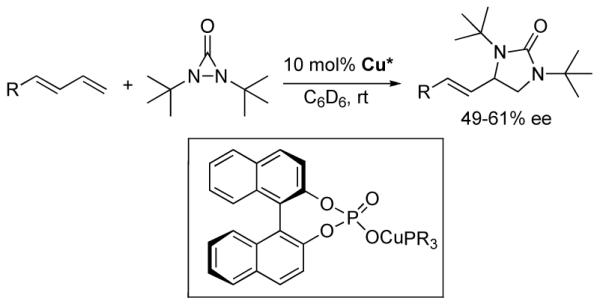
Various achiral and chiral Cu(I) salts have been prepared from mesitylcopper(I) and investigated for the diamination of conjugated olefins with 1,3-di-tert-butyldiaziridinone as nitrogen source. It has been found that copper(I) phosphate has high catalytic activity for the diamination, and encouraging ee’s have also been achieved with chiral phosphates as anionic counterions.
Vicinal diamines are contained in various biologically and chemically important molecules.1 Diamination of olefins presents an attractive approach to these diamines and has recently received intensive interest. Various metal-promoted2,3 and -catalyzed4-6 diaminations have been developed. Recently, we reported that conjugated dienes and trienes can be regioselectively diaminated with Pd(0)7,8 or Cu(I)9 as catalysts and di-tert-butyldiaziridinone10,11 as nitrogen source (Scheme 1). High enantioselectivity has also been achieved for the Pd(0)-catalyzed diamination process using tetramethylpiperidine-based phosphorus amidite ligands.7c,8b The Cu(I)-catalyzed diamination is consistent with a radical mechanism, which adds additional challenges to the development of its asymmetric process. Earlier, we reported that encouraging ee’s were obtained using (R)-DTBM-SEGPHOS as chiral ligand (Scheme 2).9b While the ee’s can be further improved by optimizing and designing chiral ligands, we have also been exploring the possibility to achieve asymmetric induction using Cu(I) catalysts bearing chiral anions.12 Herein, we wish to report our studies on this subject.
Scheme 1.

Scheme 2.

Various Cu(I) salts were prepared in situ from mesitylcopper(I) (5)13 and modifier RXH (Scheme 3).14,15 1H NMR studies with phenol, benzoic acid, and N-methylbenzenesulfonamide (Table 1, entries 7, 9, and 12) showed that the reactions between these additives and mesitylcopper(I) (5) were finished within 0.5 h. The catalytic activities of these in situ generated Cu(I) salts along with other common Cu(I) salts were investigated for diamination using 1-phenyl-1,3-butadiene (1a) as substrate. The results are summarized in Table 1. These Cu(I) salts exhibited moderate to excellent catalytic activity for diamination, giving product 4a with very high regioselectivity. The electronic property of the anionic counterions has a large impact on the catalytic activity. In general, Cu(I) salts with more electronegative anionic counterions show better activities, with CuCl displaying the highest (Table 1, entry 1). A comparable activity was observed with copper(I) diphenylphosphate (Table 1, entry 14).
Scheme 3.

Table 1.
Diamination of 1-phenyl-1,3-butadiene with copper(I) saltsa

| Entry | CuX | Conv. (%)b |
|---|---|---|
| 1 | CuCl | 98 |
| 2 | CuBr·SMe2 | 66 |
| 3 | CuI | 89 |
| 4 | CuCN | 68 |
| 5 | CuOTf | 50 |
| 6 |  |
17 |
| 7 |  |
32 |
| 8 |  |
58 |
| 9 | 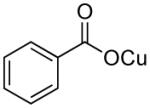 |
52 |
| 10 |  |
46 |
| 11 |  |
63 |
| 12 | 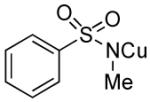 |
81 |
| 13 | 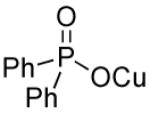 |
63 |
| 14 |  |
95 |
All reactions were carried out with olefin (0.20 mmol), 1,2-di-tert-butyldiaziridinone (2) (0.30 mmol), CuX-PPh3 (1:2) (0.020 mmol) in C6D6 (0.2 mL) at rt under argon for 24 h. For entries 6-14, catalyst RXCu was prepared in situ by stirring mesitylcopper(I) and RXH in dry C6D6 for 1 h, followed by treating with PPh3 at rt for 1 h.
Conversion was determined by 1H NMR of the crude reaction mixture.
The catalytic activities displayed by these Cu(I) salts prompted us to investigate the possibility of the asymmetric process using Cu(I) salts generated from various chiral modifiers. Various chiral molecules containing OH or NH groups were converted in situ to the corresponding Cu(I) salts by reactions with mesitylcopper(I) (5) and were then examined for diamination using 1-phenyl-1,3-butadiene (1a) as substrate (Figure 1). Modifiers Y1-Y6 gave low to moderate conversions and almost no ee’s. However, BINOL-derived chiral phosphoric acid Y7 gave diamination product 4a in 93% conversion and 48% ee.16,17 Similar results were obtained with H8-BINOL-based chiral phosphoric acid Y10. Introduction of substituents at 3,3′ or 6,6′ positions on the BINOL (Y8 and Y9) resulted in lower ee’s.18 TADDOL-derived phosphate Y11 gave no asymmetric induction.
Figure 1.
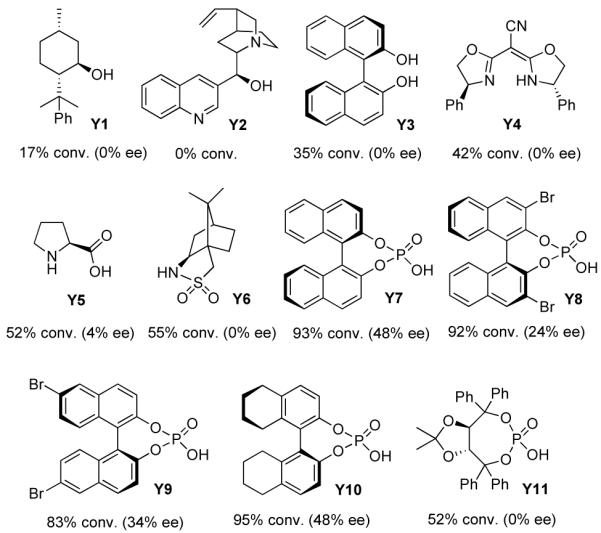
Asymmetric diamination of 1-phenyl-1,3-butadiene (1a) with chiral Cu(I) salts. All reactions were carried out with olefin (0.20 mmol), 1,2-di-tert-butyldiaziridinone (2) (0.40 mmol), R*XCu-PPh3 (1:2) (0.020 mmol) in C6D6 (0.2 mL) at rt under argon for 24 h. RXCu was prepared in situ by stirring mesitylcopper(I) and R*XH in dry C6D6 for 1 h, followed by treating with PPh3 at rt for 1 h. In the cases of Y2, Y4, and Y5, no PPh3 was used.
Chiral copper(I) phosphate can be obtained as an easily-handled solid. For example, treating Y7 with mesitylcopper(I)(5) in benzene at rt overnight afforded CuY7 as a white solid in 69% yield (Scheme 4), which can be stored in the freezer for three months without any obvious decomposition. The isolated CuY7 gave similar diamination results to the corresponding in situ generated Cu(I) salt.
Scheme 4.

With chiral catalyst CuY7 in hand, reaction conditions were further optimized for the diamination with 1-phenyl-1,3-butadiene (1a) by adding various achiral phosphine and nitrogen ligands. The ee for the diamination was improved to 55% using CuY7-tri(2-naphthyl)phosphine as catalyst in C6D6 at rt. When various conjugated dienes and a conjugated triene were subjected to these conditions, diamination products were obtained in good yields and encouraging ee’s (49-61%) (Table 2).19 For aliphatic diene such as (E)-deca-1,3-diene, however, only a trace amount of diamination product was detected from the crude 1H NMR of the reaction mixture.
Table 2.
Catalytic asymmetric diamination of conjugated dienes and trienea
All reactions were carried out with olefin (0.20 mmol), 1,2-di-tert-butyldiaziridinone (2) (0.40 mmol), CuY7-tri(2-naphthyl)phosphine (1:2) (0.020 mmol) in C6D6 (0.2 mL) at rt under argon for 30 h.
Isolated yield based on olefin.
The ee was determined by chiral HPLC (Chiralpak ADH column).
A mixture of isomers (E/Z = 1.9:1) was used, only trace amount of cis-isomer in the diamination product was observed by 1H NMR.
In summary, various Cu(I) salts were investigated for the catalytic diamination of conjugated dienes with 1,3-di-tert-butyldiaziridinone (2) as nitrogen source. The anionic counterions are shown to have a large effect on the catalytic activity for the diamination. Like CuCl, copper(I) diphenyl phosphate generated from mesitylcopper(I) and the corresponding phosphoric acid, is shown to be a highly active catalyst. Encouraging ee’s have been obtained when the diamination is carried out using chiral Cu(I) salt derived from BINOL-based chiral phosphoric acid, which provides a viable approach to an asymmetric diamination process. The applications of these chiral Cu(I) catalysts in other asymmetric reactions will be pursued.
Experimental Section
Representive diamination procedure with CuY7 generated in situ (Figure 1)
A 1.5 mL-vial containing a stir bar and (R)-(-)-1,1′-binaphthyl-2,2′-diyl hydrogen phosphate (Y7) (0.0070 g, 0.020 mmol) was evacuated and filled with Ar three times. Upon addition of dry C6D6 (0.1 mL) and mesitylcopper(I) solution (0.5 M in dry benzene, 0.04 mL, 0.020 mmol), the reaction mixture was stirred at rt for 1 h, followed by the addition of PPh3 (0.0104 g, 0.040 mmol) solution in dry C6D6 (0.1 mL). After the mixture was stirred for additional 1 h, 1-phenyl-1,3-butadiene (1a) (0.026 g, 0.20 mmol) and di-tert-butyldiaziridinone (2) (0.068 g, 0.40 mmol) were added. The reaction mixture was stirred at rt for 24 h. Diamination product 4a was formed with 93% conversion (determined by 1H NMR) and 48% ee.
Representative diamination procedure with CuY7 (Table 2, entry 1)
To a mixture of (R)-(-)-1,1′-binaphthyl-2,2′-diyl hydrogen phosphate (Y7) (1.04 g, 3.0 mmol) in dry benzene (6.0 mL) was added mesitylcopper(I) solution (0.5 M in dry benzene, 6.12 mL, 3.06 mmol) at room temperature over 5 min under argon atmosphere. The reaction mixture was stirred at rt overnight in the dark, filtered, and washed with dry benzene (2 mL) and hexane (3 mL × 2) to give CuY7 as a white solid (0.85 g, 69%).
A 1.5 mL-vial containing CuY7 (0.0082 g, 0.020 mmol) and tri(2-naphthyl)phosphine (0.0165 g, 0.040 mmol) was evacuated and filled with Ar three times. Upon addition of dry C6D6 (0.2 mL) and stirring at rt for 1 h, 1-phenyl-1,3-butadiene (1a) (0.026 g, 0.20 mmol) and di-tert-butyldiaziridinone (2) (0.068 g, 0.40 mmol) were added. The reaction mixture was stirred at rt for 30 h and purified by flash chromatography (petroleum ether:ethyl ether = 5:1, v/v) to give diamination product 4a as a white solid (0.0385 g, 64% yield, 55% ee).
Supplementary Material
Acknowledgment
We are grateful for the generous financial support from the General Medical Sciences of the National Institutes of Health (GM083944-02).
REFERENCES
- (1).For leading reviews, see:Lucet D, Gall TL, Mioskowski C. Angew. Chem., Int. Ed. 1998;37:2580. doi: 10.1002/(SICI)1521-3773(19981016)37:19<2580::AID-ANIE2580>3.0.CO;2-L.Mortensen MS, O’Doherty GA. Chemtracts: Org. Chem. 2005;18:555.Kotti SRSS, Timmons C, Li G. Chem. Biol. Drug Des. 2006;67:101. doi: 10.1111/j.1747-0285.2006.00347.x.de Figueiredo RM. Angew. Chem., Int. Ed. 2009;48:1190. doi: 10.1002/anie.200804362.Cardona F, Goti A. Nature Chemistry. 2009;1:269. doi: 10.1038/nchem.256.
- (2).For examples of metal-mediated diaminations, see: Tl:Aranda VG, Barluenga J, Aznar F. Synthesis. 1974:504.Os:Chong AO, Oshima K, Sharpless KB. J. Am. Chem. Soc. 1977;99:3420.Muñiz K. Eur. J. Org. Chem. 2004:2243.Pd:Bäckvall J-E. Tetrahedron Lett. 1978:163.Hg:Barluenga J, Alonso-Cires L, Asensio G. Synthesis. 1979:962.Co:Becker PN, White MA, Bergman RG. J. Am. Chem. Soc. 1980;102:5676.Mn:Fristad WE, Brandvold TA, Peterson JR, Thompson SR. J. Org. Chem. 1985;50:3647.
- (3).For recent Cu(II)-mediated intramolecular diamination, see:Zabawa TP, Kasi D, Chemler SR. J. Am. Chem. Soc. 2005;127:11250. doi: 10.1021/ja053335v.Zabawa TP, Chemler SR. Org. Lett. 2007;9:2035. doi: 10.1021/ol0706713.
- (4).For recent Pd(II)- and Ni(II)-catalyzed intramolecular diamination of olefins, see:Streuff J, Hövelmann CH, Nieger M, Muñiz K. J. Am. Chem. Soc. 2005;127:14586. doi: 10.1021/ja055190y.Muñiz K, Streuff J, Hövelmann CH, Núñez A. Angew. Chem., Int. Ed. 2007;46:7125. doi: 10.1002/anie.200702160.Muñiz K. J. Am. Chem. Soc. 2007;129:14542. doi: 10.1021/ja075655f.Muñiz K, Hövelmann CH, Streuff J. J. Am. Chem. Soc. 2008;130:763. doi: 10.1021/ja075041a.Sibbald PA, Michael FE. Org. Lett. 2009;11:1147. doi: 10.1021/ol9000087.
- (5).For Rh(II)- and Fe(III)-catalyzed diamination with TsNCl2, see:Li G, Wei H-X, Kim SH, Carducci MD. Angew. Chem., Int. Ed. 2001;40:4277. doi: 10.1002/1521-3773(20011119)40:22<4277::AID-ANIE4277>3.0.CO;2-I.Wei H-X, Kim SH, Li G. J. Org. Chem. 2002;67:4777. doi: 10.1021/jo0200769.
- (6).For a recent Pd(II)-catalyzed intermolecular diamination of conjugated dienes, see:Bar GLJ, Lloyd-Jones GC, Booker-Milburn KI. J. Am. Chem. Soc. 2005;127:7308. doi: 10.1021/ja051181d.
- (7).For Pd(0)-catalyzed intermolecular diamination of conjugated dienes and trienes using di-tert-butyldiaziridinone, see:Du H, Zhao B, Shi Y. J. Am. Chem. Soc. 2007;129:762. doi: 10.1021/ja0680562.Xu L, Du H, Shi Y. J. Org. Chem. 2007;72:7038. doi: 10.1021/jo0709394.Du H, Yuan W, Zhao B, Shi Y. J. Am. Chem. Soc. 2007;129:11688. doi: 10.1021/ja074698t.Xu L, Shi Y. J. Org. Chem. 2008;73:749. doi: 10.1021/jo702167u.
- (8).For related Pd(0)-catalyzed intermolecular allylic and homoallylic C-H diamination of terminal olefins using di-tert-butyldiaziridinone, see:Du H, Yuan W, Zhao B, Shi Y. J. Am. Chem. Soc. 2007;129:7496. doi: 10.1021/ja072080d.Du H, Zhao B, Shi Y. J. Am. Chem. Soc. 2008;130:8590. doi: 10.1021/ja8027394.
- (9).For Cu(I)-catalyzed intermolecular diamination of conjugated dienes and trienes using di-tert-butyldiaziridinone, see:Yuan W, Du H, Zhao B, Shi Y. Org. Lett. 2007;9:2589. doi: 10.1021/ol071105a.Du H, Zhao B, Yuan W, Shi Y. Org. Lett. 2008;10:4231. doi: 10.1021/ol801605w.
- (10).Greene FD, Stowell JC, Bergmark WR. J. Org. Chem. 1969;34:2254. [Google Scholar]
- (11).For a leading review on diaziridinones, see:Heine HW. In: The Chemistry of Heterocyclic Compounds. Hassner A, editor. John Wiley & Sons, Inc.; Hoboken, NJ: 1983. p. 547.
- (12).For a leading review on chiral anion chemistry, see:Lacour J, Hebbe-Viton V. Chem. Soc. Rev. 2003;32:373. doi: 10.1039/b205251m.
- (13).For leading references on the preparation of mesitylcopper(I), see:Tsuda T, Yazawa T, Watanabe K, Fujii T, Saegusa T. J. Org. Chem. 1981;46:192.Eriksson H, Håkansson M. Organometallics. 1997;16:4243.
- (14).For examples of generation of RXCu from RXH and mesitylcopper(I), see:Tsuda T, Watanabe K, Miyata K, Yamamoto H, Saegusa T. Inorg. Chem. 1981;20:2728.Lopes C, Håkansson M, Jagner S. Inorg. Chem. 1997;36:3232. doi: 10.1021/ic961287x.Håkansson M, Lopes C, Jagner S. Organometallics. 1998;17:210.Balogh-Hergovich E, Speier G, Huttner G, Zsolnai L. Inorg. Chem. 1998;37:6535. doi: 10.1021/ic980246t.Polyakov OG, Ivanova SM, Gaudinski CM, Miller SM, Anderson OP, Strauss SH. Organometallics. 1999;18:3769.Strieter ER, Blackmond DG, Buchwald SL. J. Am. Chem. Soc. 2005;127:4120. doi: 10.1021/ja050120c.Mankad NP, Rivard E, Harkins SB, Peters JC. J. Am. Chem. Soc. 2005;127:16032. doi: 10.1021/ja056071l.Hong S, Huber SM, Gagliardi L, Cramer CC, Tolman WB. J. Am. Chem. Soc. 2007;129:14190. doi: 10.1021/ja0760426.Fürstner A, Stimson CC. Angew. Chem. Int. Ed. 2007;46:8845. doi: 10.1002/anie.200703321.Oguadinma PO, Schaper F. Organometallics. 2009;28:4089.
- (15).For our related work on generation of tunable cyclopropanation zinc reagents (RXZnCH2Y) from RXH, see:Yang Z, Lorenz JC, Shi Y. Tetrahedron Lett. 1998;39:8621.Long J, Yuan Y, Shi Y. J. Am. Chem. Soc. 2003;125:13632. doi: 10.1021/ja030488e.Lorenz JC, Long J, Yang Z, Xue S, Xie Y, Shi Y. J. Org. Chem. 2004;69:327. doi: 10.1021/jo030312v.Du H, Long J, Shi Y. Org. Lett. 2006;8:2827. doi: 10.1021/ol0609659.
- (16).For examples of chiral phosphate-based asymmetric catalysis, see:McCarthy N, McKervey MA, Ye T, McCann M, Murphy E, Doyle MP. Tetrahedron Lett. 1992;33:5983.Pirrung MC, Zhang J. Tetrahedron Lett. 1992;33:5987.Hodgson DM, Stupple PA, Pierard FYTM, Labande AH, Johnstone C. Chem. Eur. J. 2001;7:4465. doi: 10.1002/1521-3765(20011015)7:20<4465::aid-chem4465>3.0.co;2-w.Furuno H, Kambara T, Tanaka Y, Hanamoto T, Kagawa T, Inanaga J. Tetrahedron Lett. 2003;44:6129.Suzuki S, Furuno H, Yokoyama Y, Inanaga J. Tetrahedron: Asymmetry. 2006;17:504.Mayer S, List B. Angew. Chem. Int. Ed. 2006;45:4193. doi: 10.1002/anie.200600512.Martin NJA, List B. J. Am. Chem. Soc. 2006;128:13368. doi: 10.1021/ja065708d.Hamilton GL, Kang EJ, Mba M, Toste FD. Science. 2007;317:496. doi: 10.1126/science.1145229.Rueping M, Antonchick AP, Brinkmann C. Angew. Chem. Int. Ed. 2007;46:6903. doi: 10.1002/anie.200702439.Mukherjee S, List B. J. Am. Chem. Soc. 2007;129:11336. doi: 10.1021/ja074678r.Wang X, Reisinger CM, List B. J. Am. Chem. Soc. 2008;130:6070. doi: 10.1021/ja801181u.Hamilton GL, Kanai T, Toste FD. J. Am. Chem. Soc. 2008;130:14984. doi: 10.1021/ja806431d.
- (17).For a leading review on chiral phosphoric acid-catalyzed reactions, see:Akiyama T. Chem. Rev. 2007;107:5744. doi: 10.1021/cr068374j.
- (18).When the diamination was carried out with (R)-3,3′-bis(2,4,6-triisopropylphenyl)-1,1′-binaphthyl-2,2′-diyl hydrogenphosphate (TRIP), 68% conversion and 0% ee was obtained.
- (19).Our previous work (ref. 9b) indicates that the ee of the solid diamination product could be improved by recrystallization if desired.
Associated Data
This section collects any data citations, data availability statements, or supplementary materials included in this article.












